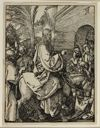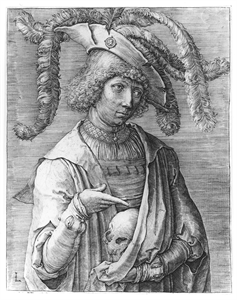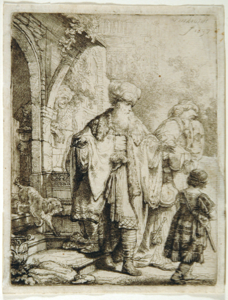
Albrecht Dürer
German, 1471–1528
From the Apocalypse, Latin edition of 1511
Perhaps the best-known woodcut from Dürer’s Apocalypse series, The Four Horsemen of the Apocalypse illustrates the third vision in the book of Revelations. Four horsemen of destruction are released from their seals and unleashed upon the world. The first rider, wearing a crown and holding a bow and arrow, is the Conqueror; the second rider, brandishing a sword, symbolizes War; followed by Famine, who carries the scales of justice; and lastly, the fourth horseman, Death, riding a “pale horse.” In the lower left corner, the Mouth of Hell opens to devour a crowned ruler. The horsemen trample a cross section of society, including members of the middle class and the peasantry. In earlier representations of this vision, the horsemen are usually depicted separately. However, by uniting the four figures in one formation as they ferociously gallop across the earth, Dürer has created a frighteningly memorable image fitting the awe-inspiring apocalyptic story.
One of the last prints executed in the series, done just prior to its initial publication in 1498, The Four Horsemen shows Dürer’s mature woodcut technique. By skillfully varying the degree and shape of the lines, he achieved a great range of tonal values. While earlier practitioners of the woodcut primarily thought of the medium as a way to provide an outline drawing to be hand-colored, Dürer demonstrated that “color” can be achieved by the line and design alone. This virtuosity in printmaking was praised by Erasmus of Rotterdam, who compared Dürer to the famed ancient painter Apelles, even rating Dürer above the classical master because he could accomplish in black and white what Apelles did in color.
German, 1471–1528
The Four Horsemen of the Apocalypse
1498From the Apocalypse, Latin edition of 1511
Object Type:
Print
Creation Place:
Northern Europe, German
Dimensions:
15 5/8 in. x 11 1/16 in. (39.69 cm x 28.1 cm)
Medium and Support:
Woodcut on heavy laid paper
Accession Number:
1991.0003.0001
Credit Line:
Gift of Mr. and Mrs. Adolph Weil, Jr., in memory of Mr. and Mrs. Adolph Weil, Sr.
Perhaps the best-known woodcut from Dürer’s Apocalypse series, The Four Horsemen of the Apocalypse illustrates the third vision in the book of Revelations. Four horsemen of destruction are released from their seals and unleashed upon the world. The first rider, wearing a crown and holding a bow and arrow, is the Conqueror; the second rider, brandishing a sword, symbolizes War; followed by Famine, who carries the scales of justice; and lastly, the fourth horseman, Death, riding a “pale horse.” In the lower left corner, the Mouth of Hell opens to devour a crowned ruler. The horsemen trample a cross section of society, including members of the middle class and the peasantry. In earlier representations of this vision, the horsemen are usually depicted separately. However, by uniting the four figures in one formation as they ferociously gallop across the earth, Dürer has created a frighteningly memorable image fitting the awe-inspiring apocalyptic story.
One of the last prints executed in the series, done just prior to its initial publication in 1498, The Four Horsemen shows Dürer’s mature woodcut technique. By skillfully varying the degree and shape of the lines, he achieved a great range of tonal values. While earlier practitioners of the woodcut primarily thought of the medium as a way to provide an outline drawing to be hand-colored, Dürer demonstrated that “color” can be achieved by the line and design alone. This virtuosity in printmaking was praised by Erasmus of Rotterdam, who compared Dürer to the famed ancient painter Apelles, even rating Dürer above the classical master because he could accomplish in black and white what Apelles did in color.
Keywords
Click a term to view the records with the same keyword
Related Objects
Click a record to view

The Beast with Two Horns Like a Lamb
1970.0015

Christ's Entry into Jerusalem
2002.0009
Portfolio List
Click a portfolio name to view all the objects in that portfolio
This object is a member of the following portfolios:
Your current search criteria is: Keyword is "BI".

 by Artist (7)
by Artist (7)


